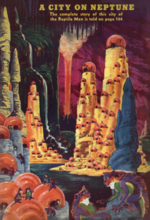Neptune is the eighth and farthest known planet from the Sun. It is the fourth-largest planet in the Solar System by diameter, the third-most-massive planet...
147 KB (14,202 words) - 22:51, 1 January 2025
Neptune, also known as Sun Multithreaded 10 GbE, is a dual 10 Gbit/s, multithreaded, PCIe x8-based network interface controller for 10 Gigabit Ethernet...
2 KB (111 words) - 07:59, 24 November 2024
up Neptune, Neptunian, Neptuno, Neptunus, or Sol VIII in Wiktionary, the free dictionary. Neptune is the eighth and farthest planet from the Sun. Neptune...
7 KB (887 words) - 00:35, 3 January 2025
(636872) 2014 YX49 Minor planets in the L4 and L5 Sun–Neptune Lagrangian points are called Neptune trojans, with a lower-case t, as "Trojan asteroid"...
38 KB (2,556 words) - 22:54, 27 December 2024
Neptune trojans are bodies that orbit the Sun near one of the stable Lagrangian points of Neptune, similar to the trojans of other planets. They therefore...
32 KB (2,315 words) - 20:37, 30 December 2024
Planets in astrology (redirect from Neptune (astrology))
cross of matter. Neptune takes 165 years to orbit the Sun, spending approximately 14 years (13.75) in each sign of the zodiac. Neptune was discovered in...
59 KB (6,320 words) - 02:31, 10 January 2025
Lagrange point (redirect from L2 Earth-Sun Lagrange point)
solar gravitational influence. The Sun–Neptune L4 and L5 points contain several dozen known objects, the Neptune trojans. Mars has four accepted Mars...
51 KB (5,703 words) - 01:24, 30 October 2024
Solar System (redirect from Sun system)
are in a simple ratio to that of Neptune: for example, going around the Sun twice for every three times that Neptune does, or once for every two. The...
223 KB (21,872 words) - 23:34, 5 January 2025
Neptune (Latin: Neptūnus [nɛpˈtuːnʊs]) is the god of freshwater and the sea in the Roman religion. He is the counterpart of the Greek god Poseidon. In...
39 KB (4,790 words) - 09:20, 2 January 2025
Pluto (section Relationship with Neptune)
bodies beyond the orbit of Neptune. It is the ninth-largest and tenth-most-massive known object to directly orbit the Sun. It is the largest known trans-Neptunian...
165 KB (14,266 words) - 23:46, 31 December 2024
Following the discovery of the planet Neptune in 1846, there was considerable speculation that another planet might exist beyond its orbit. The search...
78 KB (9,487 words) - 21:24, 2 January 2025
Neptune has appeared in fiction since shortly after its 1846 discovery, albeit infrequently. It initially made appearances indirectly—e.g. through its...
21 KB (1,973 words) - 17:00, 7 November 2024
The planet Neptune has 16 known moons, which are named for minor water deities and a water creature in Greek mythology. By far the largest of them is...
54 KB (4,583 words) - 13:33, 5 January 2025
Formation and evolution of the Solar System (redirect from Future of the sun)
consume. T Tauri stars like the young Sun have far stronger stellar winds than more stable, older stars. Uranus and Neptune are thought to have formed after...
113 KB (13,515 words) - 19:32, 10 January 2025
The Sun is the star at the center of the Solar System. It is a massive, nearly perfect sphere of hot plasma, heated to incandescence by nuclear fusion...
165 KB (18,176 words) - 02:35, 6 January 2025
provided as an overview of and topical guide to Neptune: Neptune – eighth and farthest known planet from the Sun in the Solar System. In the Solar System, it...
5 KB (365 words) - 11:26, 11 December 2024
Uranus-crossing minor planets Neptune Rings of Neptune Complete list of Neptune's natural satellites Proteus Triton Nereid Neptune trojans Neptune-crossing minor planets...
6 KB (488 words) - 17:18, 23 December 2024
The rings of Neptune consist primarily of five principal rings. They were first discovered (as "arcs") by simultaneous observations of a stellar occultation...
34 KB (3,763 words) - 12:55, 25 August 2024
located 124 light-years (38 pc) away from Earth. The planet is a sub-Neptune about 2.6 times the radius of Earth, with a 33-day orbit within the star's...
44 KB (5,105 words) - 18:26, 3 January 2025
Resonant trans-Neptunian object (redirect from Resonance with Neptune)
orbits with semi-major axes similar to that of Neptune, near the Sun–Neptune Lagrangian points. These Neptune trojans, termed by analogy to the (Jupiter)...
33 KB (3,263 words) - 17:08, 9 January 2025
Planetary symbols (section Neptune)
symbols are encoded as U+2646 ♆ NEPTUNE and U+2BC9 ⯉ NEPTUNE FORM TWO. Athena (Pallas) with her lance and Poseidon (Neptune) with his trident. These weapons...
52 KB (4,957 words) - 08:27, 30 December 2024
The planet Neptune was mathematically predicted before it was directly observed. With a prediction by Urbain Le Verrier, telescopic observations confirming...
43 KB (5,228 words) - 03:31, 13 December 2024
A Mini-Neptune (sometimes known as a gas dwarf or transitional planet) is a planet less massive than Neptune but resembling Neptune in that it has a thick...
15 KB (1,491 words) - 17:47, 28 August 2024
Voyager 2 (category Missions to Neptune)
and Saturn and enabled further encounters with the ice giants Uranus and Neptune. It remains the only spacecraft to have visited either of the ice giant...
94 KB (6,852 words) - 11:12, 30 November 2024
Solar System, extending from the orbit of Neptune at 30 astronomical units (AU) to approximately 50 AU from the Sun. It is similar to the asteroid belt, but...
118 KB (13,219 words) - 16:23, 9 December 2024
move further from the Sun in its trajectory. Voyager 2 studied Neptune's atmosphere, Neptune's rings, its magnetosphere, and Neptune's moons. The Neptunian...
24 KB (2,106 words) - 20:10, 5 December 2024
A hot Neptune is a type of giant planet with a mass similar to that of Neptune or Uranus orbiting close to its star, normally within less than 1 AU. The...
10 KB (887 words) - 21:03, 29 December 2024
The term sub-Neptune can refer to a planet with a smaller radius than Neptune even though it may have a larger mass or to a planet with a smaller mass...
4 KB (395 words) - 12:01, 21 September 2024
Triton (moon) (redirect from Neptune I)
Neptune. It is the only moon of Neptune massive enough to be rounded under its own gravity and hosts a thin, hazy atmosphere. Triton orbits Neptune in...
79 KB (7,911 words) - 06:50, 10 December 2024
be subject to perturbation by the planet Neptune. Although the closest scattered-disc objects approach the Sun at about 30–35 AU, their orbits can extend...
39 KB (4,419 words) - 20:25, 5 December 2024






















